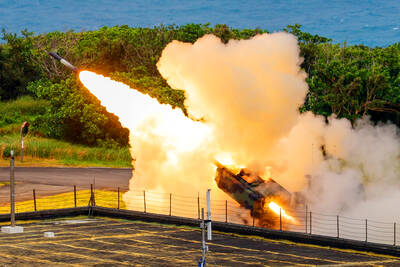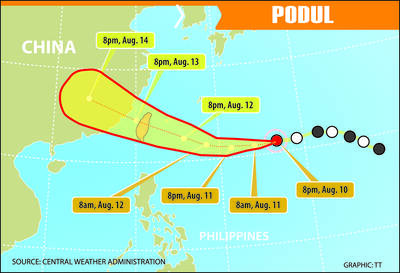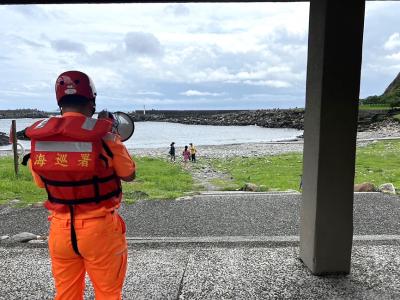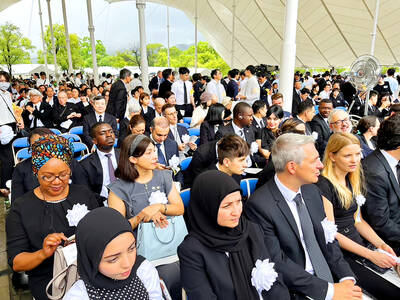Air force officials claimed yesterday that they have narrowed the focus of their investigation into last month's crash of a Mirage fighter jet off the coast of Ilan county, saying the mishap was likely the result of several possible factors, both external and human.
The officials said either a loss of consciousness during high g-force maneuvering, disorientation as a result of clouds, or problems with physical conditions -- all of which would have directly and immediately affected the pilot -- were likely causes of the fatal crash.
Colonel Chin Ping-ho (金秉和), director of the Air Force General Headquarters' flight safety department, said the cause of the crash may never be know since the pilot's body, the pilot recorder and the plane itself have not been recovered.
"There is no evidence to indicate that the pilot, Major Chiang Chin-liang (
Chin made the remarks while reporting the results of an initial investigation into the Dec. 14 crash.
Investigators' findings showed that potentially fatal problems developed as Chiang brought the plane down from an altitude of 12,800 feet to 3,300 feet.
"Chiang must have chosen a `split-S' maneuver so that he could achieve a sudden descent without changing the flight direction, as required by pre-flight instructions," Chin said.
As the plane descended from 3,780 meters, Chin said, it encountered dense clouds at about 1,500 meters.
"Judging from the available clues, we think it is also possible that Chiang might have developed spatial disorientation as he flew the plane into the dense low clouds," Chin said. "Otherwise the plane would not have plunged directly into the sea without the pilot being aware of it or trying to do something about it."
The physical condition of the pilot, Chin said, also must be taken into consideration, he said, although there have been no reports of Chiang suffering from a physical illness or discomfort before the flight.
Chin admitted, however, that the air force has yet to improve the problem of pilots' weight, as the Control Yuan suggested in its recent investigation report into the crash of a F-16 jet fighter last June off Green Island.
The weight of the F-16 pilot, Hsu Chun-wei (
"We have started working in the direction pointed out by the Control Yuan. We used to think that as long as pilots passed human centrifuge tests, they could qualify for combat training," Chin said.
"Our requirement for pilots in respect to their physical condition was their endurance against g-force. A stout figure was considered best for a combat pilot," he said. "Pilot Hsu was not fat. He was just strong, like an athlete ... and pilot Chiang did not have a problem with being overweight. He had a standard shape -- 175 centimeters tall and weighing 68 kilograms."
The air force, meanwhile, resumed Mirage flight missions yesterday after undergoing extensive security inspections, the Air Force General Headquarters (AFGH) said.
The AFGH grounded all of its French-made Mirage jets after one of those planes crashed off Taiwan's east coast during a training flight on Dec. 14.
"Special inspections of the Mirage fighters have already been completed and most of them have been equipped with beacons which can send signals to facilitate recovery or salvage in case of crashes," said an air force official.

DEFENSE: The first set of three NASAMS that were previously purchased is expected to be delivered by the end of this year and deployed near the capital, sources said Taiwan plans to procure 28 more sets of M-142 High Mobility Artillery Rocket Systems (HIMARS), as well as nine additional sets of National Advanced Surface-to-Air Missile Systems (NASAMS), military sources said yesterday. Taiwan had previously purchased 29 HIMARS launchers from the US and received the first 11 last year. Once the planned purchases are completed and delivered, Taiwan would have 57 sets of HIMARS. The army has also increased the number of MGM-140 Army Tactical Missile Systems (ATACMS) purchased from 64 to 84, the sources added. Each HIMARS launch pod can carry six Guided Multiple Launch Rocket Systems, capable of

TRAJECTORY: The severe tropical storm is predicted to be closest to Taiwan on Wednesday and Thursday, and would influence the nation to varying degrees, a forecaster said The Central Weather Administration (CWA) yesterday said it would likely issue a sea warning for Tropical Storm Podul tomorrow morning and a land warning that evening at the earliest. CWA forecaster Lin Ting-yi (林定宜) said the severe tropical storm is predicted to be closest to Taiwan on Wednesday and Thursday. As of 2pm yesterday, the storm was moving west at 21kph and packing sustained winds of 108kph and gusts of up to 136.8kph, the CWA said. Lin said that the tropical storm was about 1,710km east of Oluanpi (鵝鑾鼻), Taiwan’s southernmost tip, with two possible trajectories over the next one

Tropical Storm Podul strengthened into a typhoon at 8pm yesterday, the Central Weather Administration (CWA) said, with a sea warning to be issued late last night or early this morning. As of 8pm, the typhoon was 1,020km east of Oluanpi (鵝鑾鼻), Taiwan’s southernmost tip, moving west at 23kph. The storm carried maximum sustained winds of 119kph and gusts reaching 155kph, the CWA said. Based on the tropical storm’s trajectory, a land warning could be issued any time from midday today, it added. CWA forecaster Chang Chun-yao (張竣堯) said Podul is a fast-moving storm that is forecast to bring its heaviest rainfall and strongest

CRITICISM: It is deeply regrettable that China, which is pursuing nuclear weapons, has suppressed Taiwan, which is pursuing peace, a government official said Representative to Japan Lee Yi-yang (李逸洋) yesterday accused Beijing of interference after Taiwan’s official delegation to the Nagasaki Peace Memorial Ceremony in Japan was assigned seating in the “international non-governmental organizations [NGO]” area. “Taiwan is by no means an international NGO, but a sovereign nation that is active on the international stage,” Lee said. Lee and Chen Ming-chun (陳銘俊), head of the Taipei Economic and Cultural Office (TECO) in Fukuoka, attended the ceremony in Nagasaki yesterday, which marked the 80th anniversary of the atomic bombing of the city. That followed Lee’s attendance at the Hiroshima Peace Memorial Ceremony on Wednesday